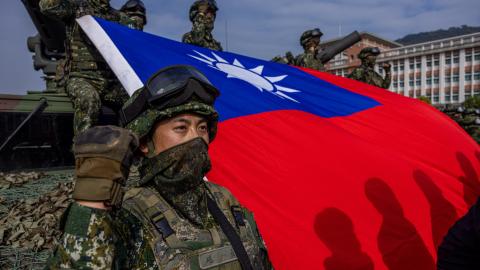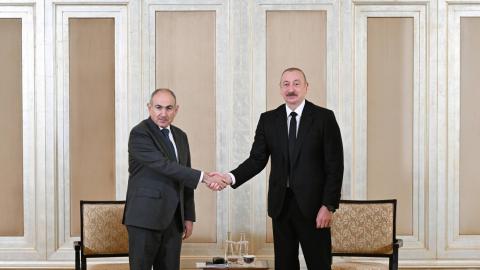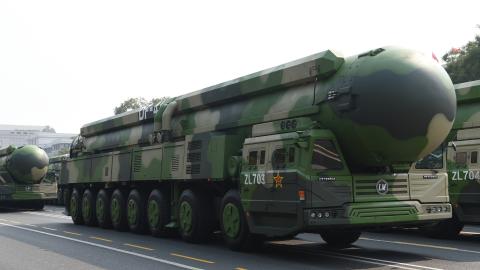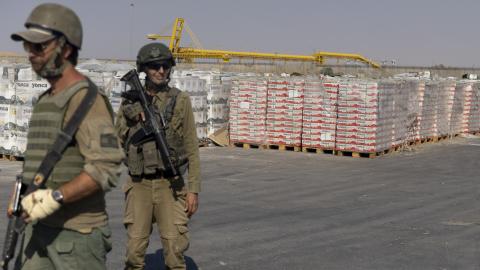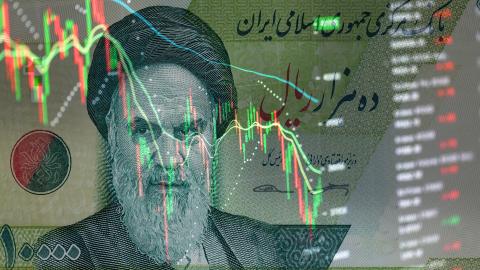Aside from Egypt, perhaps no place in the world was more galvanized by the events in Cairo's Tahrir Square last year than Washington. American policymakers and foreign policy experts on both sides of the aisle rallied behind the cause of the young men and women who braved violence at the hands of the country's notoriously vicious state police to march for freedom.
The Obama administration saw its defense of the revolutionaries, and its eventual demand that Hosni Mubarak step down, as a fulfillment of the promise the president made in his June 2009 Cairo speech that he and the United States would stand alongside young Muslims, supporting their best dreams and highest aspirations. Officials from the previous White House saw the revolution as a vindication of George W. Bush's freedom agenda and the comeuppance of a despot who stood in the way of his people's hopes.
A year after the uprising that toppled Mubarak, the bright hope lit by young Egyptians taking their fate, and their country's, into their own hands has begun to fade beyond recognition. The first indication that the political energies unleashed by the two-week uprising were not entirely salubrious was a mob's sexual assault against American journalist Lara Logan in the middle of Tahrir Square. While some tried to pin this awful crime on pro-Mubarak thugs, subsequent manifestations of mob violence and its political commitments showed that the masses were moved by forces that had nothing to do with the old regime.
A week after Mubarak's resignation, a long-exiled Muslim Brotherhood preacher, Yusuf al-Qaradawi, returned to Cairo, where he drew a massive crowd to Tahrir and led it in a communal prayer that ended with martial chants to march on Jerusalem. In September, a mob directed by soccer supporters stormed the Israeli Embassy, whose diplomats and security officials barely escaped with their lives. Several fatal attacks on Coptic Christians, including bombings and burnings of churches, culminated in an incident in October when at least 22 people, most of them Copts, were killed in a clash with the army, urged on and assisted by Muslim bystanders.
If the situation looks bad to the revolution's admirers from afar, it is even worse for the fate of the uprising. The young, nominally liberal-minded cadres that first took to the streets have been effectively shut out of the parliament, as recent elections awarded the Muslim Brotherhood and the ultra-conservative Salafi movement more than two-thirds of the seats. Worse for Egypt is that tourism--a key source of national income--is drying up, capital is fleeing the country, foreign direct investment is vanishing, and the Islamists have no practical solutions to rescue an economy in free-fall. Even optimists can console themselves only with the notion that Egypt is going to have pass through a very dark tunnel before it reaches the light. And those, like myself, who expressed doubts about the purpose and direction of the uprising even as it unfolded will find it very difficult to read these two recent accounts of last winter without feeling sad and wishing the reality were otherwise.
Ashraf Khalil's Liberation Square and Wael Ghonim's Revolution 2.0 are perhaps best read in tandem--not least because Khalil's version describes in first-person detail the events that shook the Middle East and that Ghonim missed while he was held in prison for 11 days. It wasn't until Ghonim was released from jail that he saw how his social-media campaign, waged on Facebook and Twitter, had helped bring down a pharaoh--and made him an international hero.
Brief as his detainment was, Ghonim's two understated chapters of his time in chains and blindfolded deserve to become part of the canon of classic prison literature. Fearful of jeopardizing any of the thousands of protesters whose names he had on the laptop that was captured along with him, he insisted that his role in promoting the protests against the Mubarak regime derived from his love for Egypt. Indeed, he even showed respect for the security officials who persecuted him and his colleagues.
The most moving exchanges in the book are between Ghonim and one of his interrogators, who was injured in the 1990s fighting terrorists "who attacked the homes of peaceful Egyptians," he explains to Ghonim, "like your family and mine." Ghonim told his captor that he opposed the rigging of elections and the emergency law, and gave his interlocutor a chance to respond.
"Although he didn't think the situation was ideal," Ghonim writes, "he nevertheless believed it was the lesser of two evils, since without this regime Egypt would quickly sink into an abyss of mayhem and political discord." It takes physical courage to go to jail for your political convictions, and intellectual courage to accord your political opponent respect for predicting Egypt's future reality.
While Ghonim has written the inside story of the social-media techniques he used to build a revolutionary constituency, Khalil paints a bigger picture. A longtime Middle East correspondent based in Cairo, the Egyptian American Khalil explains that he was not merely a witness to history but also a participant. Nonetheless, he offers a solid journalistic account that places the Egyptian revolution in a regional context and details the events over the past decade that led to Mubarak's downfall. Among other catalysts leading to the January 2011 uprising, Khalil lists the March 2003 protests against the U.S. invasion of Iraq, when demonstrators overran Egyptian security forces.
However, it was the Iraq war that led to the Bush administration's pressure on Mubarak, which Khalil believes also set the stage for the Egyptian revolution. In particular, he credits a "harsh speech" that Secretary of State Condoleezza Rice delivered at the American University of Cairo in June 2005, demanding that the Mubarak regime open up the political system. "Bush and Rice probably won't be remembered too fondly in Egyptian history," Khalil writes. "But this brief window--when America abandoned regional realpolitik--deserves to be remembered generously."
Ghonim and Khalil agree that there were two proximate causes of the Egyptian uprising. First was the revolution in Tunisia. "The sight of the Tunisians," Khalil writes, "accomplishing what Egyptians couldn't do had rekindled that semidormant sense of Egyptian competitive pride." Second was the killing of Khaled Said. In June 2010, half a year before the Tunisian revolution began, the 28-year-old Said was beaten to death outside a cybercafe in Alexandria by two policemen, with no apparent motive other than to terrorize someone weaker. Said's death and the subsequent cover-up, says one of Khalil's sources (an Egyptian blogger called Sandmonkey), "showed the middle class that their devil's bargain with the Ministry of Interior meant nothing. Being silent and minding their own business wouldn't protect them."
Ghonim, living at the time in Dubai, where he was working for Google, was moved by an Internet photo of Said's mangled corpse "to employ," as he writes, "all my skills and experience to demand justice"--not just for Said, but for all of Egypt. Ghonim's Facebook page "Kullena Khaled Said" ("We Are All Khaled Said") had more than 100,000 fans in less than a week and became a launching ground for the revolution, sending followers to the streets and giving them a way to stay in contact with one another.
Ghonim reprints many of the comments that appeared on the Facebook page, including some of his own impassioned pleas. These, in conjunction with his descriptions of his efforts, will doubtless be of interest to many who are invested in the notion that the uprising's prime mover was social media. However, it's not clear how much Facebook and Twitter actually had to do with bringing down Mubarak.
Once people have gone to the streets, there's little to guarantee they will stay there, especially if they are facing armed men with orders to shoot. Egyptian security forces killed hundreds of protesters over those two weeks, but compared with casualties during the 10-month uprising in Syria, where human rights groups estimate that Bashar al-Assad's security forces have killed nearly 7,000 people, the toll in Egypt was very low. Why didn't Egyptian forces commit themselves to the same levels of bloodshed? The answer goes to the essential tragedy of the revolution.
It is true, as Khalil writes, that "Hosni Mubarak was never as brutal, ruthless, or sadistic as some of his contemporaries"; moreover, it seems that the White House warned the regime against turning its weapons on civilians. But that's not why Egypt's security and military apparatus didn't send more protesters to their deaths. One of the revolutionaries' most famous chants was that the army and the people went hand in hand. However, events over the past year have shown that Egypt's beloved army is interested in one thing only--maintaining the formidable economic interests that make it the most powerful and therefore the most corrupt institution in a country where wasta (connections) and baksheesh (bribery) have made corruption systemic for centuries.
Mubarak was not the regime; he was merely the civilian facade of a military order that has ruled since Gamal Abdel Nasser overthrew the monarchy in 1952. The irony is that Mubarak made the same error as the protesters in assuming that he was the ultimate authority. His unstated but obvious desire to pass the presidency on to his youngest son, Gamal, outraged not only the demonstrators but also the army, which availed itself of the opportunity the revolutionaries had created by going to the streets. Once the White House came out against Mubarak, the old man was finished, toppled by a military coup with which both Washington and the revolutionaries had unwittingly collaborated.
The current power-sharing arrangement between the Supreme Council of the Armed Forces and the Islamists, who include some of the same terrorists that Ghonim's interrogator fought in the '90s, means that the revolution's two biggest losers are the revolutionaries and the United States. The fall of Mubarak cost Washington an ally who had kept the peace with Israel for 30 years, at some risk to his own life. The Camp David accords turned the United States into a power broker and underwrote its position in the Middle East. The Egyptian-Israeli peace treaty showed other Arab states what prizes would come to them should they simply make peace with Jerusalem: American money, American prestige and of course American weapons. The peace was for the sake not only of Israel but also of Egypt, which receives roughly $2 billion a year in U.S. assistance if it avoids risking national suicide again in another war with Jerusalem's superior, and nuclear, forces.
By appearing to turn its back on Mubarak, the United States suggested that perhaps peace with Israel isn't that important. Egypt, with more than 50 percent of its population too young to remember the devastation of the 1967 and 1973 wars, is perhaps inclined to agree. Those who dismiss the likelihood of renewed Israeli-Egyptian conflict assume that the Egyptian army does not dare forfeit the $1.3 billion that flows to it in U.S. military aid each year. However, the army's priority is not to obtain American cash but simply to stay in power. Over the past half-century, international, regional and domestic dynamics have repeatedly driven Egypt's rulers and its army to make war against Israel in spite of what would seem to be their better interests. A military that represses its people for the sake of its own wealth is liable to make any sort of mistake.
What transpired in Egypt last year was not a social-media revolution, nor was it a revolution in the sense that it overturned an existing political system. And yet, as both books show, it was a revolution insofar as Egyptians were able to change their sense of what they can accomplish in concert. Given the way that Egypt is going, it seems that they will likely have to draw on that talent again, sooner rather than later.
